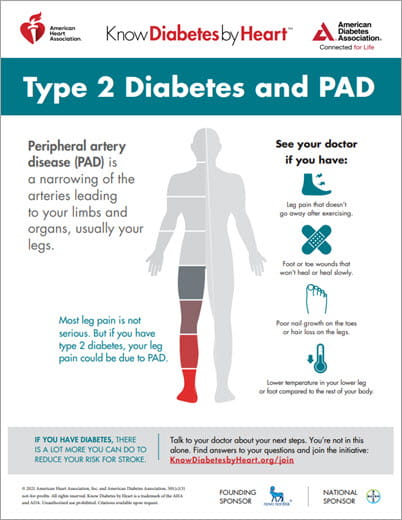Peripheral Artery Disease and Diabetes
People with diabetes are at higher risk of developing atherosclerosis, the most common cause of peripheral artery disease (PAD). And people with PAD have a much higher risk of heart attack or stroke.
PAD is similar to coronary artery disease (blockage in arteries that supply blood to the heart muscle) and carotid artery disease (blockage in arteries leading to the brain). However, with PAD, narrowed arteries reduce blood flow to the arms or legs. Fatty deposits build up in the inner linings of the artery walls of the legs, making them narrower, hindering blood flow and even stopping blood flow to the legs and feet. This condition can lead to pain, especially when walking. Other symptoms include foot wounds that heal slowly, one foot being much colder than the other or gangrene. In severe cases, foot or leg amputation may be needed.
Why does diabetes increase the risk for developing PAD?
People with diabetes are already at an increased risk for PAD. There's an even greater chance of developing PAD if one or more of these additional risk factors is present:
- Overweight/obesity
- Physical inactivity
- Smoking
- High blood pressure
- Unhealthy or abnormal cholesterol levels or high blood triglycerides
- Family history of CVD, stroke or PAD
- Inflammation
- Hypertension in pregnancy
- Chronic kidney disease
Read article: Reduce Your PAD Risk: 3 Easy Tips
Prevention and treatment of PAD
A number of the above risk factors can be controlled to reduce the chance of developing PAD or slow its progression. It’s especially important for people with diabetes to keep blood glucose levels under control. Regular physical activity is also important. Special footwear and medications also may be needed. Be sure to stop smoking, control high blood pressure and high blood cholesterol. Learn more about how to prevent and treat PAD.






